
The Stone of Eric, listed as DR 1 in the Rundata catalog, is a memorial runestone that was found in Northern Germany. This area was part of Denmark during the Viking Age.
The two Sigtrygg Runestones, designated as DR 2 and DR 4 in the Rundata catalog, are two of the Hedeby stones that were found in Schleswig-Holstein, Germany, which during the Viking Age was part of Denmark. The runestones were raised after the Danish king Sigtrygg Gnupasson by his mother Ásfriðr. Together with the account of Adam of Bremen, the two inscriptions constitute evidence for the House of Olaf on the Danish throne.

Danish Runic Inscription 66 or DR 66, also known as the Mask stone, is a granite Viking Age memorial runestone that was discovered in Aarhus, Denmark. The inscription features a facial mask and memorializes a man who died in a battle.

The Glavendrup stone, designated as DR 209 by Rundata, is a runestone on the island of Funen in Denmark and dates from the early 10th century. It contains Denmark's longest runic inscription and ends in a curse.

The Gunderup Runestone, or DR 143, is located in Gunderup, North Jutland County, Jutland, Denmark. It is notable because it is one of few runestones raised in commemoration of a woman.
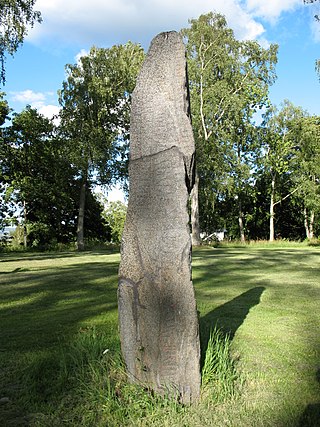
The Saleby Runestone, designated as Vg 67 in the Rundata catalog, was originally located in Saleby, Västra Götaland County, Sweden, which is in the historic province of Västergötland, and is one of the few runestones that is raised in memory of a woman.

Sønder Vissing I or DR 55 is a runestone located in the church of Sønder Vissing in eastern Jutland, Denmark. Sønder Vissing is a small settlement located in Horsens municipality approximately 20 kilometres (12 mi) south of Silkeborg, 20 kilometres (12 mi) west of Skanderborg and 40 kilometres (25 mi) northeast of the Viking monuments of Jelling.
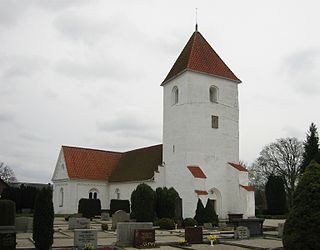
The Hällestad Runestones are three runestones located in the walls of Hällestad Church in Torna-Hällestad, about 20 kilometers east of Lund in Skåne, southern Sweden. Their Rundata identifiers are DR 295, 296, and 297. DR 295 is notable because it is held to be raised in memory of a warrior who fell in the legendary Battle of the Fýrisvellir, near Uppsala, Sweden between the Jomsvikings led by Styrbjörn the Strong and Styrbjörn's uncle Eric the Victorious, the king of Sweden, c. 985. The other stones were raised by the same people, and they probably formed a monument together in memory of comrades lost in the battle. The Karlevi Runestone, the Egtved Runestone and the Sjörup Runestone may be connected to them.
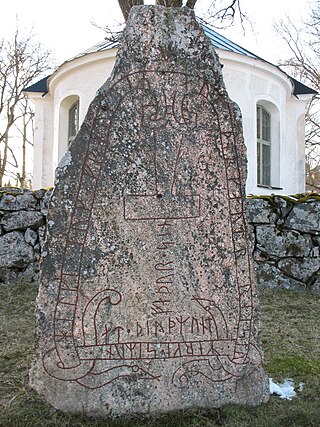
The Stenkvista runestone, designated as runic inscription Sö 111 in the Rundata catalog, is a memorial runestone located near the church at Stenkvista, which is two kilometers east of Skogstorp, Södermanland County, Sweden, which was formerly part of the historic Södermanland, and which features a depiction of Thor's hammer, Mjöllnir. This runestone is one of several runestones in Scandinavia that has a dedication to Thor. While the tradition of carving inscriptions into boulders began in the 4th century and lasted into the 12th century, most runestones in Scandinavia date from the late Viking Age.
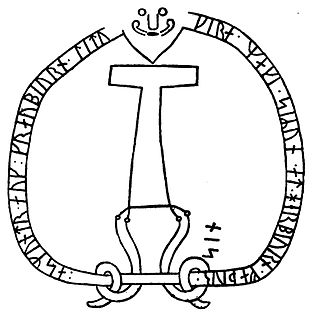
Sö 86 is the Rundata catalog number for a Viking Age memorial runic inscription located in Åby, which is about one kilometer north of Ålberga, Södermanland County, Sweden, and in the historic province of Södermanland. The inscription features a depiction of the hammer of the Norse pagan god Thor named Mjöllnir and a facial mask.

The Lund 1 Runestone, designated as DR 314 in the Rundata catalog, is a Viking Age memorial runestone originally located on the grounds of the All Saints Church in Lund, Scania, Sweden.

The Holmby Runestone, listed as DR 328 in the Rundata catalog, is a Viking Age memorial runestone bearing the image of a ship. It is in Holmby, which is about two kilometers southeast of Flyinge, Scania, Sweden.

The Bjäresjö Runestones are three Viking Age memorial runestones originally located adjacent to Bjäresjö Church in Bjäresjö, which is about 3 kilometers northwest of Ystad, Skåne County, Sweden. Two of the stones were discovered near the church, and two of the stones have been moved to other nearby locations. Although these three stones are located in Sweden, they have been given Danish designations because Scania was part of the historic Denmark.

Danish Runic Inscription 48 or DR 48 is the Rundata catalog number for a Viking Age memorial runestone from Hanning, which is about 8 km north of Skjern, Denmark. The runic inscription features a depiction of a hammer, which some have interpreted as a representation of the Norse pagan god Thor, although this interpretation is controversial.

The Västra Nöbbelöv Runestone, listed as DR 278 in the Rundata catalog, is a Viking Age memorial runestone located in Västra Nöbbelöv, which is about 3 kilometers east of Skivarp, Skåne County, Sweden, and was in the historic province of Scania.

The Ålum Runestones are four Viking Age memorial runestones which are located at the church in Ålum, which is 9 km west of Randers, Denmark. One of the stones refers to a man with the title drengr and two of the other stones were raised by the same family.

The Asferg Runestone, listed as DR 121 in the Rundata catalog, is a Viking Age memorial runestone found at Asferg, which is about 10 km northeast of Randers, Aarhus County, Region Midtjylland, Denmark.

DR 110, or the Virring stone, is a runestone made of granite that measures 155 cm (61 in) in height, 120 cm (47 in) in width and 27 cm (11 in) in thickness. It is written in Old East Norse in the Younger Futhark, and the runestone style is in a form called RAK.
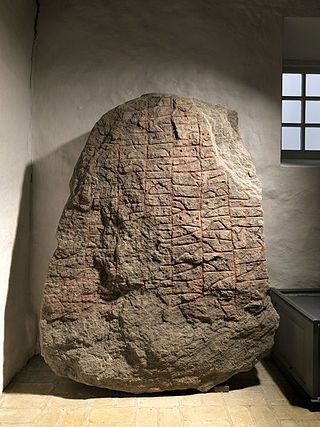
The Sønder Vinge stone 2 or DR 83 is a Viking Age runestone engraved in Old Norse with the Younger Futhark runic alphabet. The stone is in granite and was discovered in 1866 as a corner stone of Sønder Vinge Church, positioned with the runic inscription outwards. It is presently located in the porch of the church. It is probably from the period 970-1020 due to runic and linguistic features. It is 180 cm tall, 132 cm wide and 35 cm thick. Parts of the runic inscription have eroded which makes some runes hard to read. The style of the runestone is the runestone style RAK.

The Glemminge stone or DR 338 is a Viking Age runestone engraved in Old Norse with the Younger Futhark runic alphabet. It is found in the wall of Glimminge church in Scania, in Ystad Municipality in Sweden. The style of the runestone is the runestone style RAK.






















